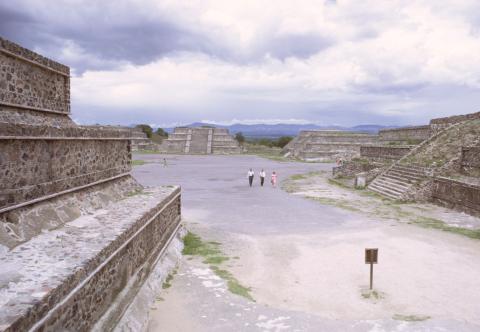
1167627600
Three tourists walk down the middle of a dirt street between several very tall stone pyramids. The pyramids are constructed of various levels with steep stairs. Teotihuacan is the name of a Mesoamerican indigenous civilization and its grandest city, once the largest city in Mexico. The Teotihuacan people predated the Maya by over five hundred years, and the Aztec by more than a thousand years. The civilization of Teotihuacan reached its height in the 1st century CE (AD) when the huge pyramid to the sun was built. The estimated population of the city at its largest varies from 150,000 to 250,000. Artisans of the city are known for the sweeping grandeur of the buildings they left behind, and numerous artifacts made from obsidian, a black volcanic rock indigenous to the region. The reason for the decline of the city and its civilization after 450 CE (AD) is unknown. Some archaeologists hypothesize that climate change and severe droughts led to internal unrest that may have caused the destruction of the city. Today, Teotihuacan is a popular tourist destination replete with museums and ongoing archaeological investigation. The main path between the pyramids in Teotihuacan is called the "Avenue of the Dead."
Creative Commons BY-NC-SA
 1167627600
1167627600